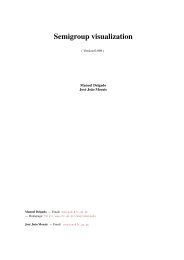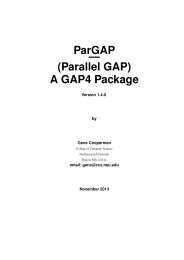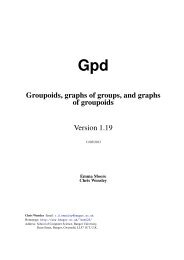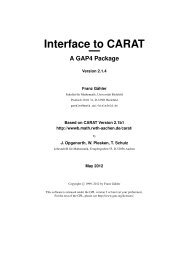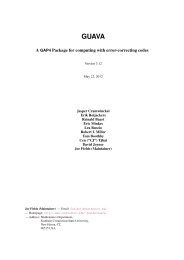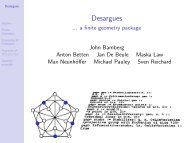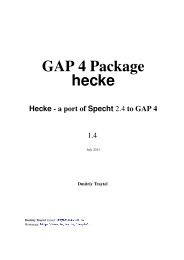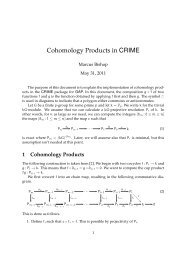Final Test in MAT 410: Introduction to Topology Answers to the ... - Gap
Final Test in MAT 410: Introduction to Topology Answers to the ... - Gap
Final Test in MAT 410: Introduction to Topology Answers to the ... - Gap
You also want an ePaper? Increase the reach of your titles
YUMPU automatically turns print PDFs into web optimized ePapers that Google loves.
7. R with <strong>the</strong> usual <strong>to</strong>pology is a compact <strong>to</strong>pological space.<br />
true ( ) false ( X )<br />
The open cover R = ∪ n∈Z ]n, n + 2[ does not possess a f<strong>in</strong>ite subcover.<br />
8. R with <strong>the</strong> Zariski <strong>to</strong>pology is a compact <strong>to</strong>pological space.<br />
true ( X ) false ( )<br />
See Exercise 29.<br />
9. R with <strong>the</strong> usual <strong>to</strong>pology is a connected <strong>to</strong>pological space.<br />
true ( X ) false ( )<br />
The only sets <strong>in</strong> R which are both open and closed are ∅ and R.<br />
10. R with <strong>the</strong> Zariski <strong>to</strong>pology is a connected <strong>to</strong>pological space.<br />
true ( X ) false ( )<br />
No subset of R is both f<strong>in</strong>ite and has a f<strong>in</strong>ite complement – so <strong>the</strong> above holds also<br />
here.<br />
11. All Hausdorff spaces with countably many po<strong>in</strong>ts are compact.<br />
true ( ) false ( X )<br />
Counterexample: Z with <strong>the</strong> discrete <strong>to</strong>pology. – Then <strong>the</strong> open cover consist<strong>in</strong>g of<br />
<strong>the</strong> 1-element subsets possesses no f<strong>in</strong>ite subcover.<br />
12. In a compact metric space, every sequence of po<strong>in</strong>ts has a convergent subsequence.<br />
true ( X ) false ( )<br />
See Theorem 7.22 <strong>in</strong> <strong>the</strong> script.<br />
13. F<strong>in</strong>ite <strong>to</strong>pological spaces are always connected.<br />
true ( ) false ( X )<br />
Counterexample: discrete <strong>to</strong>pological space with at least 2 po<strong>in</strong>ts.<br />
14. F<strong>in</strong>ite <strong>to</strong>pological spaces are never connected.<br />
true ( ) false ( X )<br />
Counterexample: any f<strong>in</strong>ite set with <strong>the</strong> trivial <strong>to</strong>pology.<br />
15. There are Hausdorff spaces which are <strong>to</strong>tally disconnected.<br />
true ( X ) false ( )<br />
Example: discrete <strong>to</strong>pological spaces.<br />
16. Let Z be endowed with <strong>the</strong> <strong>to</strong>pology where <strong>the</strong> open sets are <strong>the</strong> set-<strong>the</strong>oretic unions<br />
of residue classes. Then f : Z → Z, n ↦→ n + (−1) n is an homeomorphism.<br />
true ( X ) false ( )<br />
The function f maps unions of residue classes <strong>to</strong> unions of residue classes, so it is<br />
an homeomorphism.<br />
17. The set S ⊂ R n (n ∈ N) of zeros of a polynomial P ∈ R[x 1 , . . . , x n ] is always<br />
bounded, and its diameter is bounded above by <strong>the</strong> product of <strong>the</strong> coefficients of P .<br />
true ( ) false ( X )<br />
Counterexample: <strong>the</strong> set of zeros of <strong>the</strong> zero polynomial is R n , and hence unbounded.<br />
18. Let A be a bounded subset of R 3 , and let B ⊂ R 3 be a superset of A such that<br />
B \ A is f<strong>in</strong>ite. Then <strong>the</strong> diameter of B is <strong>the</strong> same as <strong>the</strong> diameter of A.<br />
true ( ) false ( X )<br />
B may conta<strong>in</strong> a po<strong>in</strong>t ‘far away’ from A.<br />
4



